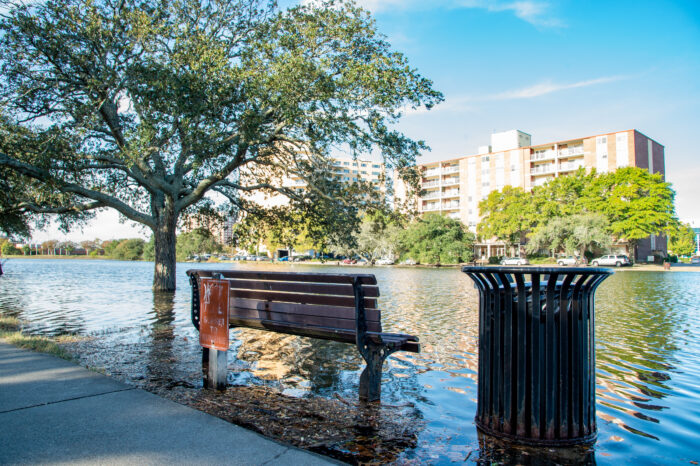Why are we still building in flood prone areas?
Developing in the floodplain is rarely a good idea – it puts people who live or work there at risk of flooding and often destroys natural resources like wetlands that absorb floods and keep communities from harm, filter pollutants, and provide wildlife habitat.
So why do we keep doing it?
In Charleston, South Carolina, a 9,000-unit development plans to put more than half of its units in the floodplain. In North Carolina, much of the area surrounding the $500 million-dollar Mid-Currituck bridge is expected to be underwater in 30 years, rendering it useless.
When we build publicly funded infrastructure and other projects in flood prone areas, we’re not only putting people and buildings at direct risk of flooding, but we’re also wasting taxpayer dollars with costly repairs and replacements as storms strengthen and sea levels rise.

In fact, in the last 10 years, flood-related disasters have required over $72 billion from FEMA’s Public Assistance Program to conduct repairs to public buildings and infrastructure.
At long last, the Biden administration is moving forward with federal policy that requires agencies to look at future flood risk when considering development proposals, and one agency just became the first to cement it into regulations.
“Our communities and environment will only see the full benefit from this new standard once all federal agencies follow through on its promise and start investing in long-term solutions,” says Liz Zepeda, federal regulatory director at SELC.
Done properly, this policy will help ensure more responsible federal investments in flood-prone areas, better stewardship of our communities and floodplains, and major long-term savings for communities and taxpayers.
What’s the federal standard?
Today, the U.S. Department of Housing and Development (HUD) finalized their Federal Flood Risk Management Standard (FFRMS) rule, moving us a step closer to a better nationwide policy on flooding and smarter decisions about federal investments.
HUD is leading the way for other agencies that need to get with the program.
Liz Zepeda, Federal Regulatory Director
The standard requires federal agencies like HUD to account for climate impacts like sea level rise and stronger storm surge when considering development in flood-prone areas, extending important protections and construction standards to those in truly at-risk areas.
“We’re finally getting smarter about development in the floodplain, but there’s more to do,” said Sierra Weaver, leader of SELC’s Coast and Wetlands Program. “We need to steer new development away from flood-prone areas and plan better when that’s the only option.”
How does the flood risk standard promote smarter development?
The federal flood risk standard does two important things. First, agencies must consider how climate change is affecting flood patterns and weather conditions at proposed development locations. If this information indicates that the site is likely to experience flooding, project managers must look for alternative locations outside the risky area. Federal funds can be used to develop in a floodplain only if there are no viable alternatives.

Second, it requires that any unavoidable floodplain development is built in a way that makes it safer and more resilient by considering nature-based solutions and mitigation measures for flood risks. It also directs agencies to build in ways that reduce damage to the floodplain itself and avoid pushing flood waters to surrounding communities.
Here’s a good example from the South: The proposed Mid-Currituck Bridge would need to be operational for over 30 years for the state Department of Transportation to collect enough toll revenue to pay for it. Yet sea level rise maps show that much of the area surrounding the bridge will be underwater within the next 30 years.
Had the Federal Highway Administration applied the flood risk standard, it would have considered how sea level rise will affect the project area and identified alternatives to avoid, minimize, and mitigate risk. It could have also led the agency to a project plan that would stand the test of time.
More agency action on flood risk is needed
By finalizing their flood risk rule strengthening protections for affordable housing, HUD is seizing the opportunity to keep more and more people from harm’s way and ensuring federally assisted housing is built to last.
“We need swift implementation to make sure we’re siting and building our neighborhoods in a way that reduces the need for costly repairs and replacements in the face of increasing floods,” said Sarah Edwards, legislative counsel at SELC.
There are other agencies on the right track: the U.S. Army Corps of Engineers is proposing to codify a flood risk rule soon, although it is already implementing the standard in other ways. FEMA is also already partially implementing the standard and hopefully finalizing a rule later this year. The Department of Transportation has plans to publish a proposed rule updating its floodplain management rules this summer.
This commonsense update to assessing flood risk is much-needed progress that benefits our communities, environment, taxpayer dollars, and future generations.
Sarah Edwards, SELC Legislative Counsel
But not all federal agencies have implemented the flood risk standard, even though doing so could make a huge impact on our communities and environment.
We need the Army Corps, FEMA, and DOT to finalize their proposals as soon as possible, and we need all federal agencies to recognize the importance of building in a safer and more resilient way.
